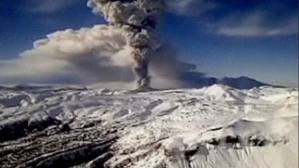As fluctuating ash plumes ground flights in New Zealand and Australia, a clearer picture of the volcanic activity in Chile causing the disruption is emerging.
 From volcanologists Dr Tom Wilson at the University of Canterbury and Dr Graham Leonard at GNS Science. Tom and Graham work closely with USGS and other volcanologists researching volcanic ash impacts.
From volcanologists Dr Tom Wilson at the University of Canterbury and Dr Graham Leonard at GNS Science. Tom and Graham work closely with USGS and other volcanologists researching volcanic ash impacts.
The international Smithsonian / US Geological Survey (USGS) Weekly Volcanic Activity Report has just been released with the following nice summary of the week’s activity at Puyehue-Cordón Caulle volcano:
It describes ongoing explosive eruptions at the volcano producing ash clouds to elevations that can entrain that ash in the east-travelling jetstream. Once ash is in the jetstream there remains a strong chance of that ash continuing to travel its 5-6 day journey the long way around the Southern Hemisphere towards New Zealand airspace.
From the Volcanic Activity Report:
OVDAS-SERNAGEOMIN [The agency responsible for monitoring the vocanic activity in Chile] reported that the eruption from the Cordón Caulle rift zone, part of the Puyehue-Cordón Caulle volcanic complex, that began on 4 June continued on 5 June. At least five pyroclastic flows were generated from partial collapses of the eruptive column and traveled N in the Nilahue River drainage. The pyroclastic flows were possibly 10 km long. On 6 June the continuous ash plume changed direction and was blown ENE as far as 178 km while the previous portion of the plume continued to drift ESE over the ocean. On 7 June the Buenos Aires VAAC reported that ash plumes rose to altitudes of 5.5-9.8 km (18,000-32,000 ft) a.s.l. and were 65-95 km wide.
OVDAS-SERNAGEOMIN reported that on 8 June satellite imagery showed a 1,200-km-long eruption plume drifting NE, then SE over the Atlantic Ocean. Personnel working in the area reported that the ash plume rose 7.5 km above the crater. On 9 June climatologic conditions prevented ground-based observations of the plume, however satellite imagery showed a 200-km-long plume drifting NE. Pumice and vitreous tephra had accumulated in many area lakes and rivers, and ash had turned many rivers darker.
Despite poor visibility due to meteorological conditions on 10 June, the plume was observed to have risen 3.7 km above the crater and drifted SE. News articles stated that flight disruptions continued in Argentina and Uruguay, and flights from airports in Brazil had been cancelled. On 11 June the plume was whiter than previous days and rose to heights 4-4.5 km above the crater and drifted 350 km E. A dispersed plume was detected as far as 600 km ENE. Some flights resumed in affected parts of Chile, Argentina, and Uruguay.
An overflight on 11 June revealed that the vent was located at the head of the Nilahue River’s basin, immediately to the N of the 1960 eruption fissure location. Abundant amounts of ash had accumulated around the vent as well as to the E and SW. Ash plumes rose 4-4.5 km above the crater; an explosion that day caused an ash plume to rise 8 km above the crater. On 12 June seismicity was relatively stable except for four hybrid earthquakes and a pulse of tremor that lasted about 2 hours and 40 minutes.
A series of explosions (up to 8 events per minute) were also registered. Very dense, dark gray ash plumes rose 8 km above the crater. Satellite imagery showed a distinct eruption plume drifting 300 km E, with a diffuse plume reaching 1,000 km ENE. According to news articles, the ash plume that had been drifting mostly E since the beginning of the eruption
had reached Australia and beyond, causing flight cancellations in southern Australia and New Zealand.
Scientists aboard an overflight on 13 June observed the plume height oscillating and noted that the eruptive vent diameter was 300-400 m. Gas-and-steam plumes rose from two or three locations along the same fissure as the eruptive vent. Pulses of tremor were associated with dark gray ash plumes that rose 9 km above the crater. Ashfall and column collapses were noted. At night incandescence from the base of the plume reached 1.5-2 km high.
Satellite imagery showed the plume drifting 250 km SE. On 14 June explosions generated pyroclastic flows (that traveled N), with associated ash-and-gas plumes. Based on analysis of satellite imagery, the VAAC stated that ash plumes rose to altitudes of 5.5-7.6 km (18,000-25,000 ft) a.s.l. while previously emitted ash plumes drifted NE, E, and SE at altitudes of 0.9-3 km (3,000-10,000 ft) a.s.l. SERNAGEOMIN reiterated that the Alert Level remained at 6, Red.
Geologic Summary
The Puyehue-Cordón Caulle volcanic complex (PCCVC) is a large NW-SE-trending late-Pleistocene to Holocene basaltic-to-rhyolitic transverse volcanic chain SE of Lago Ranco. The 1799-m-high Pleistocene Cordillera Nevada caldera lies at the NW end, separated from Puyehue stratovolcano at the SE end by the Cordón Caulle fissure complex.
The Pleistocene Mencheca volcano with Holocene flank cones lies NE of Puyehue. The basaltic-to-rhyolitic Puyehue volcano is the most geochemically diverse of the PCCVC. The flat-topped, 2236-m-high Puyehue volcano was constructed above a 5-km-wide caldera and is capped by a 2.4-km-wide summit caldera of Holocene age. Lava flows and domes of mostly rhyolitic composition are found on the eastern flank of Puyehue.
Historical eruptions originally attributed to Puyehue, including major eruptions in 1921-22 and 1960, are now known to be from the Cordón Caulle rift zone. The Cordón Caulle geothermal area, occupying a 6 x 13 km wide volcano-tectonic depression, is the largest active geothermal area of the southern Andes volcanic zone.